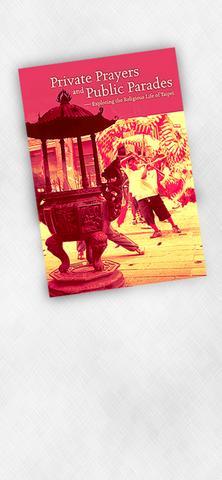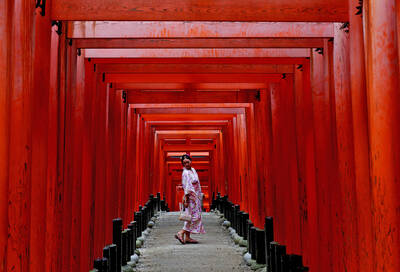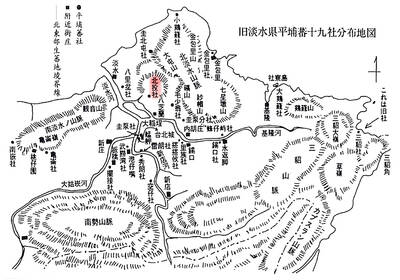The first time I met Mark Caltonhill he was blowing water up his nose and out of his ear, or perhaps it was the other way round. He was warming up an audience before an English-language theater performance and friends told me that not long before he'd been hanging from an art gallery ceiling regaling the passers-by with jokes. Now here he is in the public eye again, this time as the author of a book on the religious life of Taipei.
There's no doubt that Caltonhill has a remarkably versatile talent. We've heard of Zen monks playing practical jokes which carry a profound significance, but this is something rather different. Caltonhill is versatile because his theater performance was very funny and this book is remarkably informative, enlightening and even scholarly. He has many different strings to his bow.
The first thing to strike you on picking the book up is the photographs. There are many, most of them taken by the author, and they are a delight, throwing a varied and often unexpected light on his subject. Who would have thought a picture of a young girl in a denim jacket against a sky of blue and white could be so relevant! "A Taipei citizen checks out the `wind and clouds' for possible rain but not for the results of future wars as her ancestors might have done," runs the caption, and all is explained.

I'm not being facetious. This is a genuinely enjoyable book. The problem when writing such things is essentially one of tone. Present your material too matter-of-factly and it seems banal and boring. Present it with too prominent a sense of humor and the devout people it describes will be up in arms. Caltonhill steers a course between these two attitudes and gets it just right.
As a non-Chinese he is clearly unlikely to urge on other non-Chinese readers the reliability of divination and fortune-telling, or how to protect yourself effectively from the perils of the Ghost Month. On the other hand, this book is published by the Taipei City Government and the religious practices of Taipei's citizens must therefore be described with sympathy and a generous measure of respect. Caltonhill is notably successful in performing this difficult balancing act.
When someone graduates in Chinese from a major UK university such as Edinburgh you expect him to be capable intellectually. And so this author proves. He summarizes the many different traditions that combine to create Taipei's modern religious scene effortlessly. He describes the ceremonies that accompany birth, marriage and death, and yet manages to grace such momentous events with a light touch which, without ever being in the least bit sarcastic, makes them interesting and easy to take on board.
A book of this kind, in other words, could very easily be portentous, patronizing and even offensive. This is none of these things. It's interesting without overburdening you with excessive information, and entertaining without ever approaching being irreverent.
The range of the book is also admirable. You go from tomb-sweeping to vegetarianism, dragon boats to passing exams, green mountains to blue-eyed barbarians. You want to know about crouching tigers, bribing the kitchen god, immortality, or the Lunar New Year? It's all here.
One of the more bizarre experiences foreigners experience in Taiwan is being asked what their blood-type is. I can never remember mine, but this book is well aware of the cult, noting in passing that interest in the subject as a source of information for character-reading is a recent innovation.
There are such incidental insights everywhere in this eminently painstaking book. Tibetan-style Buddhist funerals are gaining in popularity, you learn. The English phrase joss money derives from the Portuguese word deos, meaning god. And the mischief traditionally practiced in the bridal chamber at a Chinese wedding originated from the desire to trick malign fox spirits into thinking there was no need to plague the newly married couple because it had already been done. Or so it's claimed -- a more mundane motive is hard not to credit.
One risk with a book like this is that it'll become a dreary recital of traditions that, though still practiced, are a long way from the world modern young Taipei people live in. Caltonhill avoids this pitfall too, not exactly by irony but instead by a kind of tartness. "One of the strangest sights in Taipei is that of ambulances speeding dying people away from hospitals," he writes. He goes on to explain the reasons, calmly and without bias. It would have been easy for someone with less poise to expatiate on how superior this is to the characteristic Western experience of death in an intensive care unit, far from friends and cultural traditions. It would be equally easy for someone to point to the paradoxical mixture of high-tech and spirit-worship in the Taiwanese world. But this author does neither. He just states and explains. This is a great virtue.
We all bring our own cultural assumptions to a foreign place, and as a result see it wrongly -- see it, in other words, merely as an imperfect version of our own country. Nothing could be more mistaken. Read this book and Taiwan and Taipei will seem different places, and much closer, probably, to how they really are.
There is a short section on imported religions. There isn't room for much detail, but still Caltonhill manages to include some insights -- such as that it was the expulsion of Western missionaries by the Japanese in the 1940s that led to the indigenization and autonomy of Taiwan's Christian churches.
Taiwan's reputation, in Hong Kong and elsewhere, is strong on two things -- ghosts and eating. This book fills you in on the former most comprehensively. Perhaps Caltonhill can now be persuaded to undertake a book on the equally wide range of Taipei's food. But one thing is certain -- Private Prayers and Public Parades will be a hard act to follow.

Seven hundred job applications. One interview. Marco Mascaro arrived in Taiwan last year with a PhD in engineering physics and years of experience at a European research center. He thought his Gold Card would guarantee him a foothold in Taiwan’s job market. “It’s marketed as if Taiwan really needs you,” the 33-year-old Italian says. “The reality is that companies here don’t really need us.” The Employment Gold Card was designed to fix Taiwan’s labor shortage by offering foreign professionals a combined resident visa and open work permit valid for three years. But for many, like Mascaro, the welcome mat ends at the door. A

The Western media once again enthusiastically forwarded Beijing’s talking points on Japanese Prime Minister Sanae Takaichi’s comment two weeks ago that an attack by the People’s Republic of China (PRC) on Taiwan was an existential threat to Japan and would trigger Japanese military intervention in defense of Taiwan. The predictable reach for clickbait meant that a string of teachable moments was lost, “like tears in the rain.” Again. The Economist led the way, assigning the blame to the victim. “Takaichi Sanae was bound to rile China sooner rather than later,” the magazine asserted. It then explained: “Japan’s new prime minister is

NOV. 24 to NOV. 30 It wasn’t famine, disaster or war that drove the people of Soansai to flee their homeland, but a blanket-stealing demon. At least that’s how Poan Yu-pie (潘有秘), a resident of the Indigenous settlement of Kipatauw in what is today Taipei’s Beitou District (北投), told it to Japanese anthropologist Kanori Ino in 1897. Unable to sleep out of fear, the villagers built a raft large enough to fit everyone and set sail. They drifted for days before arriving at what is now Shenao Port (深奧) on Taiwan’s north coast,

Divadlo feels like your warm neighborhood slice of home — even if you’ve only ever spent a few days in Prague, like myself. A projector is screening retro animations by Czech director Karel Zeman, the shelves are lined with books and vinyl, and the owner will sit with you to share stories over a glass of pear brandy. The food is also fantastic, not just a new cultural experience but filled with nostalgia, recipes from home and laden with soul-warming carbs, perfect as the weather turns chilly. A Prague native, Kaio Picha has been in Taipei for 13 years and